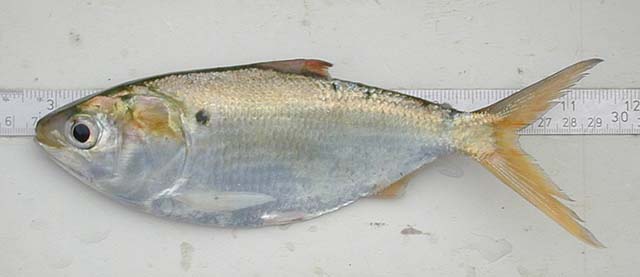| Clupeidae (Herrings, shads, sardines, menhadens), subfamily: Dorosomatinae |
| 45 cm TL (male/unsexed) |
|
pelagic-neritic; depth range - 0 m, catadromous |
| Atlantic Ocean: Eastern central Atlantic Ocean from Dakhla in Western Sahara to Lobito Bay in Angola (Ref. 188, 81269, 81631). Reports from Cape Verde Islands are based on an erroneous type locality for Clupea fimbriata by Bowdich (1825) which was followed by later authors (Ref. 188). |
|
Dorsal spines (total): 0-0; Dorsal soft rays (total): 16-19; Anal spines: 0-0; Anal soft rays: 19-23. Diagnosis: Ethmalosa fimbriata is distinguished from other clupeids by the presence of a median notch on the upper jaw, into which tip of lower jaw fits (Ref. 188, 81269). A faint dark spot behind gill cover, sometimes followed by others; dorsal fin tip black; caudal fin deep chrome yellow; golden tints on body (Ref. 188). Ethmalosa fimbriata resembles Sardinella aurita, Sardinella rouxi and especially Sardinella maderensis, but these are more slender, have a rounded upper jaw which is not notched and the upper gillrakers are not bent upward like an elbow (Ref. 188).
Description: Body fairly deep, compressed, scutes present along belly (Ref. 188, 2849, 81269, 81631). Upper jaw with distinct median notch, into which tip of lower jaw fits (Ref. 188). Adipose eyelid very well developed (Ref. 2849, 81269, 81631). Lower gillrakers long, fine and numerous, about 3 times as long as gill filaments, upper gillrakers bent sharply upward, V-shaped (Ref. 188). Dorsal fin with 16-19 rays; anal fin with 19-23 rays; pelvic fin with 1 unbranched and 7 branched rays; caudal fin tips long and pointed (Ref. 188, 2849, 81269, 81631). Scales lacinate on posterior margin, numbering 37-42 in a longitudinal series; 16-19 prepelvic and 10-13 postpelvic midventral scutes (Ref. 2849, 81269, 81631).
Colouration: Alcohol-preserved specimens are silvery, with the back brownish to greenish (Ref. 2849, 81269, 81631). A rounded black spot behind the upper part of operculum, sometimes followed by one or less visible spots aligned in a longitudinal series (Ref. 188, 2849, 81269, 81631). Dorsal fin tip black; caudal fin deep chrome yellow ; golden tints on body (Ref. 188). |
| Ethmalosa fimbriata is found in coastal and estuarine regions, and sometimes also in lower courses of coastal rivers, even more than 300 km up rivers (Ref. 188, 81269, 81631). It feeds by filtering phytoplankton, chiefly diatoms (Ref. 188). It breeds throughout the year in waters of salinities 3.5-38 ppt, but with peaks in at least some areas; spawns in the sea, in estuaries and in rivers (Ref. 188). |
|
(Ref. 96402)
|
| harmless |
|
Source and more info: www.fishbase.org. For personal, classroom, and other internal use only. Not for publication.
Page created by Jen, 05.08.02,
php script by kbanasihan 06/09/2010 ,
last modified by
dsantos, 20/08/10

